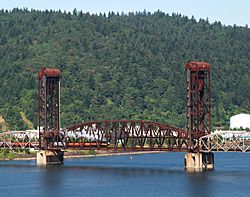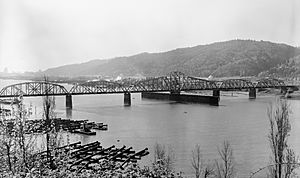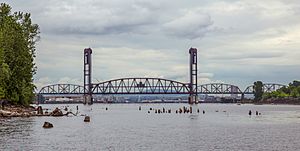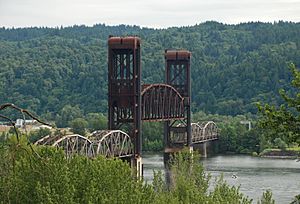Burlington Northern Railroad Bridge 5.1 facts for kids
Quick facts for kids Burlington Northern RailroadBridge 5.1 |
|
|---|---|
 |
|
| Coordinates | 45°34′38″N 122°44′48″W / 45.57730°N 122.74678°W |
| Carries | 2 railroad tracks, used by freight trains and by Amtrak toward Seattle or Spokane |
| Crosses | Willamette River |
| Locale | Portland, Oregon |
| Owner | BNSF Railway |
| Characteristics | |
| Design | 1989 to present: Vertical-lift bridge 1908–89: Swing bridge |
| Total length | 1,763 feet (537 m) |
| Longest span | 516 feet (157 m) |
| Number of spans | 5 |
| Clearance below | 200 feet (61 m) when lift span fully raised |
| History | |
| Opened | 1908; main span replaced 1989 |
The Burlington Northern Railroad Bridge 5.1, also known as the St. Johns Railroad Bridge, is a special railway bridge in Portland, Oregon. It crosses the Willamette River and has a part that can lift up, called a vertical lift. This bridge is used by freight trains and Amtrak passenger trains.
It was first built in 1908 and was a swing bridge, meaning a part of it would swing open to let boats pass. At that time, its swing section was the longest in the world! Later, in 1989, the main part of the bridge was changed to a vertical-lift design. This made the river channel wider for ships. The lift part of the bridge is now one of the highest and longest of its kind anywhere.
The bridge is owned by the BNSF Railway. The "5.1" in its name tells us it's 5.1 miles from Portland's Union Station. Out of 12 bridges over the Willamette River in Portland, this is the only one used only by trains. It's also the only one not open to the public.
Contents
The Bridge's Story
The original bridge was built between 1906 and 1908. It was part of a new railway line connecting Vancouver, Washington and Portland. This line was built by a company called the Spokane, Portland and Seattle Railway (SP&S). This company was created by two larger railway companies, the Northern Pacific Railway and the Great Northern Railway. They wanted to build new train lines from Portland to Seattle and Spokane.
Building the First Bridge
The SP&S railway line included two other big bridges over the Columbia River. A famous bridge engineer named Ralph Modjeski designed all three bridges in 1905. He suggested that all of them should have swing sections that could open.
However, for the Willamette River bridge, some people were worried. River boat pilots thought a swing bridge, which needs a center support, would make the shipping channel too narrow. Many big ships used this part of the river. Other bridges in Portland at the time also had swing sections with center supports, which made it hard for large boats to pass.
After much discussion, it was decided to go with the swing design. Construction of the Willamette River bridge started in August 1906. Its swing section was truly impressive, measuring about 521 feet long. This made it the longest swing span in the world at the time!
The whole project took over two years to finish. The main structure was ready in July 1908. The first train crossed the bridge on October 23, 1908. Regular train service began in November of that year.
The swing section of the bridge was very heavy, weighing around 4.6 million pounds. It had a backup generator in case the main power went out. This meant the bridge could still open for boats.
In 1970, the bridge's ownership changed to the Burlington Northern Railroad (BN) when SP&S merged with other railways. Later, in 1996, BN merged again to become the Burlington Northern and Santa Fe Railway, which is now known as BNSF Railway.
A Big Change: Becoming a Lift Bridge
The bridge's center swing section was replaced with a vertical-lift span and tall towers. This big project took two years and was finished in 1989. It was mostly paid for by a grant from the government.
Why the change? Over the years, many ships had hit the old swing bridge. The center support pier of the swing bridge was seen as a problem for river navigation. The U.S. Coast Guard decided it was time for a change. They approved a $38 million grant to help pay for the work.
Changing to a vertical-lift design meant the central support pier could be removed. This made the navigation channel much wider. It also allowed larger ships to reach the Port of Portland's ship repair facility at Swan Island.
The change was planned very carefully to cause as little trouble as possible for both river and train traffic. The old swing section was removed on August 8, 1989, and the new lift section was put in place just 72 hours later, on August 11. Three months later, the old pivot pier was removed using dynamite. This made the river channel much wider, from 230 feet to 497 feet.
The new lift section is about 516 feet long. It is one of the longest vertical-lift spans in the world. When it's fully raised, it provides 200 feet of space above the water. The new lift section weighs about 7.9 million pounds. It's made of a special type of steel that rusts naturally to a reddish-brown color. However, the older parts of the bridge are painted silver. This gives the bridge two different colors, which some people find unusual.
How the Bridge Works Today

The bridge has two tracks for trains. It is used by freight trains and Amtrak passenger trains. Even though the BNSF Railway owns the bridge, other railway companies are allowed to use it. This is because of an old law that says railway bridges over navigable rivers must be available for common use.
Signals on both sides of the bridge stop trains when the lift section is up. As an extra safety step, all trains must radio the bridge operator for permission to cross. A bridge operator is on duty 24 hours a day, every day of the year.
About 30 to 35 trains cross the bridge each day.




